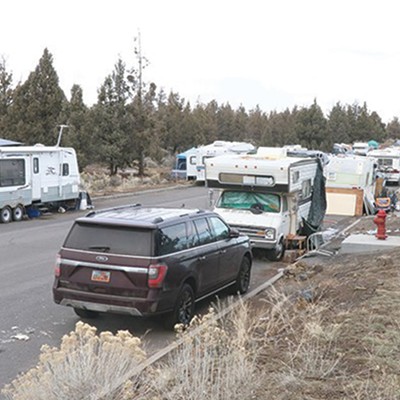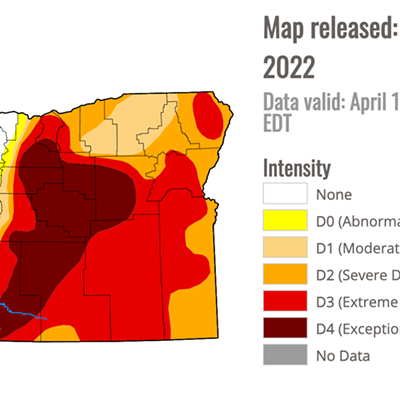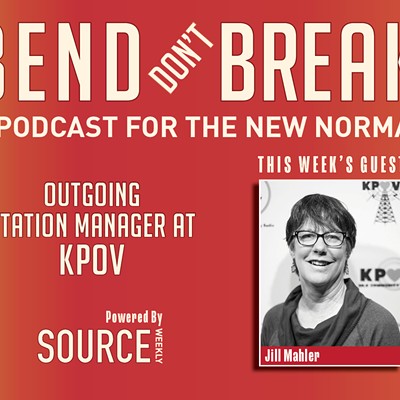Often times, when tackling a tough subject, such as an illness or a tragedy, you might get a glimmer of hope at the end. A lesson learned. A silver lining. But if you're looking for a happily ever after here, don't hold your breath. Deschutes County sits in in a crippling mental health and housing crisis, and hope is hard to come by.
The fighters on the frontline
"Our biggest mental institution right now is jail," begins Dr. Maryanne Straumfjord, a psychiatrist at Deschutes County Behavioral Health. Straumfjord says in her five years in the county, she has "seen the gamut" of mental illness, but predominantly sees patients with depression, bipolar disorder, post traumatic stress disorder (PTSD), anxiety and psychosis. She estimates that 30 percent of her patients are currently homeless, and that mental illness, unemployment, low income and incidences of legal involvement have the greatest impact on finding and keeping housing.
Deschutes County Behavioral Health and its team of psychiatrists, crisis team responders, doctors and counselors are ground zero in the fight against mental illness and substance abuse. County residents, whether they are insured or not, can go there to find some help—but resources are limited. The recent proposed Oregon budget for 2017-19 estimates a 28 percent cut in spending for the Oregon Health Authority, which includes the Oregon Health Plan, that helps fund this behavioral health clinic—and that's before the proposed cuts that could come at the federal level.
"There are always environmental stressors that trigger mental illness," Straumfjord says, "and being homeless is a horrendous stressor." Take for example a patient with bipolar disorder. Sometimes, the extreme worry and anxiety over finding stable housing or employment can set off bipolar incidents, especially when a patient isn't on medication. "I had a patient with bipolar disorder who lost her housing," Straumfjord says. "She's been camping out all year long and she's scared because she can't get out of it. 'There's no way out. I try, and try, and try, try, try and I'm stuck,' she says. And that's a tremendous stressor added on to the difficulties in finding a job, both because she's homeless and she can't even take a shower or charge her cell phone. Maintaining a job while she's having episodes of depression or mania triggered by homelessness is very hard."
In a recent article in this series, profiling people living in the Redmond homeless camps, a frequent reader reaction was: "Why can't they just get over it and get a job?" To this, Straumfjord says, "I would say, OK, if you have somebody in congestive heart failure, having a heart attack or someone who has severe chronic back pain, would you tell them to suck vit up and go back to work? It's the same thing with emotional illness. It's a chemical change in the brain, it's something that causes behavior that isn't voluntary. It's not something you go out and say, try harder. That's a dangerous notion."
The foundation of mental illness
In the mid 1990s, Kaiser Permanente and the Center for Disease Control (CDC) founded the Adverse Childhood Experience Study or ACES, which now includes over 70 accredited research papers. The study shows that when one experiences childhood trauma, it harms that child's developing brain so immensely that the effects can show up years later. The more ACEs a person has stacked up, the increased chances of triggered mental illness, chronic disease, substance abuse, violent and impulsive behavior and early death. ACEs includes childhood traumas such as physical, sexual and verbal abuse, physical and emotional neglect, a family member who is depressed, has mental illness, is addicted to alcohol or substances or is in prison, witnessing domestic violence and losing a parent in either divorce or death.
Those who are exposed in very high doses can have triple the lifetime risk of heart disease, lung cancer and a 20-year difference in life expectancy. At the Redmond homeless camps, a 28-year-old camper, identified as Chelsea, made this poignant statement. "If it looks like we are out here by choice, you're wrong. Everyone out here has been soaked in trauma." And she's right, according to the Substance Abuse and Mental Health Services Administration, 25 percent of homeless people in the U.S. suffer from some sort of mental illness.
ACES are extremely common. It is estimated that 67 percent of the population has at least one ACE, and 12.6 percent has four or more. The problem lies in the number of ACEs a patient has.
"There are always environmental stressors that trigger mental illness and being homeless is a horrendous stressor." - Dr. Maryanne Straumfjord
tweet this
The ACEs also shows that early adversity affects the pleasure and reward center in our brains, linked to substance dependence. It hinders the prefrontal cortex, which impedes impulsive control and supports high risk behaviors. Dr. Nadine Burke Harris, a pediatrician who gave a 2014 TED talk on the subject, cited that on "MRI scans, we see measurable differences in the amygdala, the brain's fear response center. So there are real neurologic reasons why folks exposed to high doses of adversity are more likely to engage in high-risk behavior."
Mental illness and substance abuse: compounding challenges
"A lot of patients who we see have had difficult trauma backgrounds. They have a lot of ACEs," says Karen Tamminga, adult outpatient treatment supervisor at Deschutes County Behavioral Health. In 2016, the center saw 3,433 adult patients, 241 of which were homeless. An estimated 7,800 adults with severe mental illness reside in Central Oregon alone. One in five adults report depression, and there are on average 38 suicides in Central Oregon per year. "The majority of patients who have mental illness have had trauma. Many of those turn to substances to cope with their trauma or mental illness. Not all, but a fair percentage," says Tamminga. She cites alcohol, marijuana, methamphetamine and heroin as the top four abused drugs in Deschutes County. "Not all substance abusers have mental illness," she continues, "Although those drugs all cause changes in the brain, and can cause depression and anxiety."
When a person struggles with mental illness and then turns to substances to cope, the barriers to find and keep housing become even more immense. Some deal with disabilities and chronic illnesses as well, making finding and keeping a stable job even more difficult. Tamminga adds: "Those looking for housing often can't afford first and last month's deposit, let alone the application fees. So, they make difficult choices such as do they eat? Do their children eat? Or do they apply for housing and hope to get on a waiting list to better their life?"
She admits that the county has limited funding to deal with the issues at hand, but that they try to help patients with application fees, transportation, car repairs or with paying small bills. Case managers also try to help with organizational skills. "When dealing with mental illness, the stress and sense of overwhelm impacts your ability to be organized," she adds. "You are not able to focus on filling out forms, returning them in a timely manner and get everything together. Our case managers help with that."
Still, when we asked Tamminga to point us toward a "success story"—a former patient who's now living in stable housing, for example—that we could share for this article, she was unable to point one out.
State and local resources for housing: An uphill climb
In an attempt to close Oregon's $1.7 billion budget gap, Gov. Kate Brown has suggested closing the Junction City state psychiatric hospital and cutting funding for community-based developmental disability programs—showcasing Oregon's disconnect with mental illness. If Measure 97 would have passed, for example, an estimated $3 billion in revenues would had been raised, enough to close the gap. With its failure, and with the new administration, budget cuts are looming.
Dr. Nathan Boddie, a Bend city councilor and primary care physician, acknowledges the tough uphill battle the city faces with finding solutions for affordable housing, much less for those dealing with the compounded issues of mental illness and/or substance abuse. "When you add those factors in, people really fall off the cliff," he says. "In the housing market that we have here, there really isn't any wiggle room for individuals who struggle with mental illness or substance abuse to navigate the complex application process to find housing." He continues, "What do we do to break the cycle then? That's the trick. Plainly put, we don't have enough resources to address the problem."
One proposed solution
His solution? The "Housing First" model — a permanent supportive housing solution that provides low entry barriers for people who don't meet the requirements to obtain a house. "Once in," he says, "The brick and mortar have social services, treatments and case managers, it's a comprehensive home with services attached to it." Boddie adds: "It's the only evidence-based effective approach to a chronic homeless situation that works." Straumfjord agrees, though says supportive living facilities such as those are at the moment rare to find and hard to get into—but that they may be the only way patients can be successful.
"I watch the City Council and the zoning going on and low-cost housing and it's a quagmire that's not getting solved fast enough. And I don't see it getting solved, either," Straumfjord says. When asked about the critics, Boddie says, "I would agree. I am one of them. I think we can't move fast enough and we are already behind the curve." He illustrates his point by saying, "We are using the same sort of approaches we have used for years. Which aren't bad, it's essentially using our revolving loan fund to build affordable units that we put families into. But we need different housing policies that address chronic housing shortages."
An estimated 7,800 adults with severe mental illness reside in Central Oregon alone. One in five adults report depression, and there are on average 38 suicides in Central Oregon per year.
tweet this
He says that all too often, the first thing that critics turn to is land-use law. "It's nonsense that we can't build houses. Yes, we need land, but we also need the housing policies to promote affordability and protection for renters. The real hurdles will be financial and organizational." He adds: "We'll need the housing subsidies through the state to make their way to us. We got less federal funding in the last funding cycle because we weren't doing enough innovative things to combat the problem. Unfortunately, we have limited tools in the city government because we don't have much money to throw around — as you can see in the conditions of roads, for example."
Among the people working on solutions, it's clear the consensus is that the approach—and the funding for mental illness and housing—must change. "Local people could give to local services," says Tamminga. "Unfortunately, in our state, often services are the first things that are cut out of state budgets. So knowing what local services that are helping those in our community, food programs like NeighborImpact, or COVO (Central Oregon Veterans Outreach), services that pay deposits, that have case managers with loan applications, support those locally."
"I don't know if I'm optimistic, but I'm determined," says Boddie, "because we need to do something and we need to redouble our efforts. I think funding is a big barrier as is political will. It's hard to remain hopeful."
Straumfjord adds, "With this administration, no. I don't remain hopeful. C'mon! We need more funding, not cuts. We need more help. Our community is really suffering."
Resources:
ACEs Study
www.deschutesunitedway.org/aces
Deschutes County Behavioral Health
www.deschutes.org/health/page/behavioral-health
Housing First
www.usich.gov/solutions/housing/housing-first
Nadine Burke Harris




























